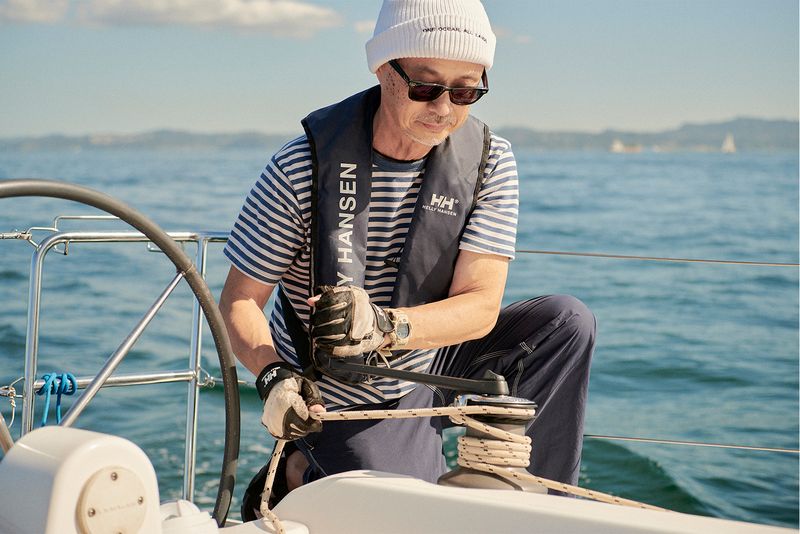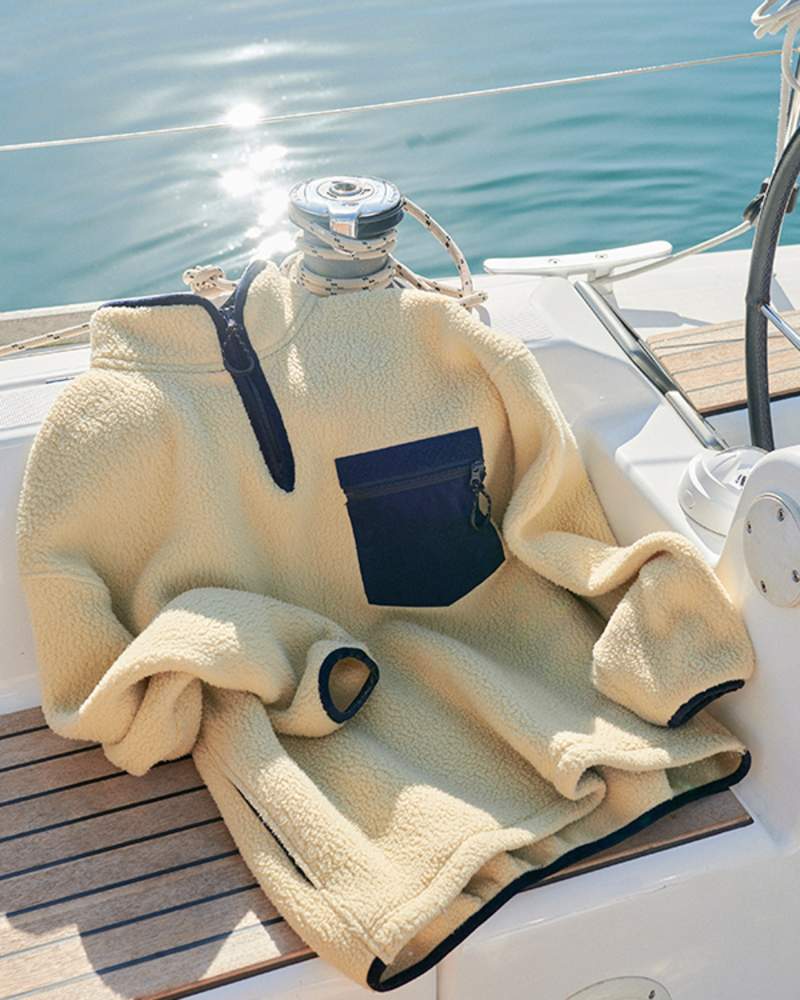THE JOURNAL

Mr Eiichiro Homma, founder of nanamica, on his sailboat Nanamica in Uraga, Japan
Mr Eiichiro Homma, the founder of the Japanese brand nanamica, has always charted a unique life course, going all the way back to his fashion choices as a small child. “Japanese students all wear traditional leather backpacks called randosel, but within one year of elementary school, my friend and I decided to never wear them again. Then we decided to stop wearing shorts, even in the summertime.” Later in college, when his friends were obsessing over rugged American garments such as Levi’s 501 jeans and rugby shirts, Mr Homma had already moved on to the latest in European style. As the soaring Japanese economy made BMWs as common as Toyota Corollas on the streets of Tokyo in the early 1980s, Mr Homma was hitting the city’s high-end restaurants and clubs in Armani-style suits.
Today, however, Mr Homma claims to be finished with this dogged pursuit of difference. He knows what he likes and sticks to it. His confidence is perhaps based in the fact that nanamica has come to enjoy constant recognition around the world for its unique combination of high-performance technical fabrics and understated, elegant design. But the success of the brand offers us a new puzzle: how did a European style-obsessed, sociology major end up being such a pioneer of the “outdoor chic” that is now so central to the world of global menswear?
In hindsight, Mr Homma’s journey towards nanamica makes perfect sense. During college, he found part-time work in the skiing industry, at the exact time when exploding economic growth made alpine sports a status symbol for growing legions of young yuppies. Mr Homma recalls, “From December to April, I was almost always in the mountains working on the ski slopes or with promoters.” By the time he joined the Japanese sportswear manufacturer Goldwin after graduation, he was already a seasoned professional with four years of on-the-ground experience and an encyclopedic memory of industry trends. When Mr Homma joined the company, Goldwin was enjoying modest success with The North Face licence, but the CEO planned to dive into the marine sports business as well. “If The North Face was the army,” Mr Homma explains, “he intended to also have a navy.” Mr Homma became the brand manager for Norwegian sailing brand Helly Hansen and was tasked with developing new items for the Japanese market.

With no designers on staff, Mr Homma had to pull out the pencils and sketch everything himself. “My drawings were so terrible,” he admits, but by the end of the 1980s, his primitive scrawls landed Goldwin a major hit. As companies were pouring their huge entertainment budgets into yachts for executive use, all the weekend sailors (and their landlubbing imitators) ran out to buy Mr Homma’s Helly Hansen neon nylon sailing jacket featuring the extra-large HH logo status marker that would be visible many knots yonder.
The appeal of Helly Hansen at the time may have been tied to conspicuous consumption, but in developing products for the brand, Mr Homma became an expert in high-performance sportswear. “You need to know how textiles protect body heat, protect against wind and rain, but at the same time, you want to allow freedom of movement.” Sharing the same research and development “kitchen” as The North Face, Mr Homma began to experiment with the latest in high-tech fabrics such as Gore-Tex, which have since become core to his work.
Mr Homma left the Helly Hansen team in 2001 to oversee new business development for Goldwin, but entering his forties, he wanted work with a true sense of personal risk. So in 2003, he founded his own brand nanamica, together with the designer Mr Takashi Imaki, who had helped make American athletic brand Champion one of Japan’s most beloved casual lines. The name nanamica means “house of the seven seas” in Japanese, reflecting aspirations towards an adventurous sporting life as well a dream to reach all of mankind. The formula for the brand was obvious: “I thought, if we do our original label that’s a good mixture of technical sportswear and fashion, we would have a strong advantage over other companies. The aim was to create the ultimate mix of fashion-function together with no compromise.”


Mr Homma wanted to open the nanamica store in the tranquil Daikanyama shopping district of Tokyo, but with no open space, he had to wait. In the meantime, he got to work on an equally big opportunity: The North Face Purple Label, which would be the world’s first The North Face line with a fashion focus. “I took the traditional 1980s The North Face garments, but gave them the slimmer shapes that were in style at the time,” says Mr Homma. “It looked classic while still using the latest down technology.”
Purple Label was an immediate success, and soon nanamica was also up and running in Daikanyama with its own hit items. The most iconic nanamica pieces live up to Mr Homma’s original intentions: garments that look like classic menswear from afar, but on closer inspection, deploy space-age materials for maximum performance. The brand’s signature piece is its Gore-Tex® Soutien Collar Coat – a flattering classic A-line mid-length jacket that offers nearly supernatural resistance to rain and wind. Mr Homma explains the secret behind his work: “Many designers just duplicate parts of the design without any knowledge of the logical features of those details. But I know why this shape is diagonal, or why this panel must be here. And so I know how should I take those elements and use them in fashion.” Recently, nanamica has used this approach to make business garments as well: the brand’s suit jackets in non-wrinkle materials can go straight from an overnight transcontinental flight to a boardroom meeting in the morning.
Following nanamica’s collections over the years, it’s apparent that Mr Homma has a clear vision for the brand. The newest pieces never stray too far from the back catalog. “Our black-and-white sketches always look the same, but there are differences in fit, the combinations of fabric, and the colour palette.” Despite this consistency, nanamica manages to keep things fresh thanks to ongoing technical innovations and a playful spirit. Both are visible, for example, in the ALPHADRY Club Jacket, where a traditional houndstooth pattern from British textile mill Abraham Moon is printed atop a lightweight polyester fabric – so that you can wear tweed even in the summer.

The brand’s designs work well on the streets of urban Tokyo, but true to its name, they look even better out on the water. Mr Homma and his friends maintain a sailboat at Uraga, near the American Yokosuka Naval Base. (Lest anyone be confused about the owners, the boat is named… Nanamica.) His love of sailing, surprisingly, was not immediate. “After I joined Goldwin, I’d go out to the harbour to sail, but everyone recognised me as being from the industry. So they’d ask me, ‘Where can I buy that waterproof jacket? How do I get my jacket repaired?’ I always felt like I was on duty. But over time, I realised, I should enjoy this opportunity. The company gives me access to the boat and pays all my expenses.” Those extravagant days of corporate yachting may be over, but all for the better: Mr Homma wants his sailing to be pure leisure and not another workplace task. His remaining challenge is now just finding the right conditions to get out on the water. “It’s not easy, especially in summer,” admits Mr Homma. “The weather, wind, schedule have to all be right.”
Fortunately for Mr Homma, the conditions for nanamica’s overall success have never been stronger. With expanded distribution across the globe and a generation of young men obsessed with the fashion-function hybrid garments that Mr Homma helped invent, nanamica is poised to be Japan’s next breakout brand. It may have started in one little spot on the Pacific, but nanamica is on its way to outfitting explorers across all seven seas.
Mr W David Marx is an American writer living in Tokyo, Japan. He is the author of Ametora: How Japan Saved American Style